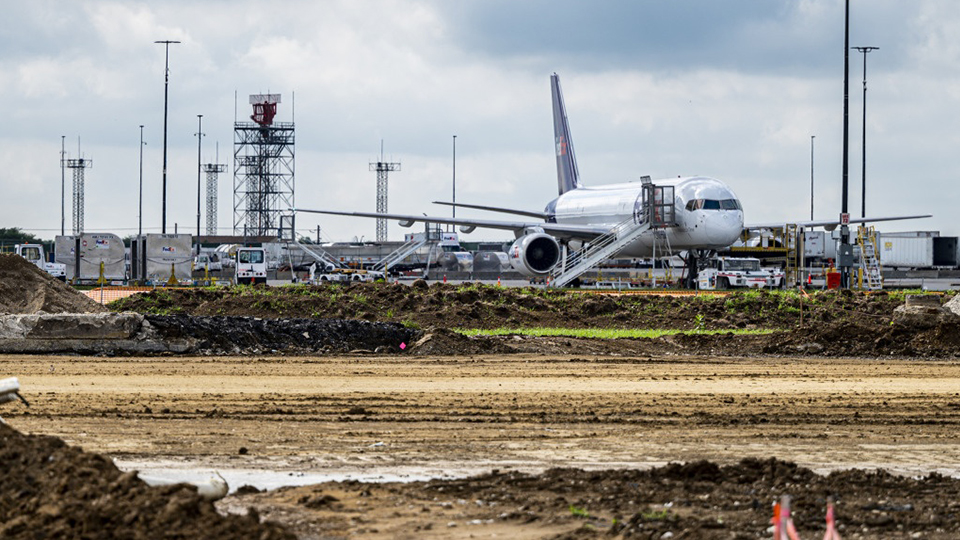Runway rebuild project takes off at Indianapolis International Airport
Subscriber Benefit
As a subscriber you can listen to articles at work, in the car, or while you work out. Subscribe Now
Indianapolis International Airport is undergoing its most ambitious project since the completion of the new Midfield Terminal in 2008—a $190 million rebuild of one of its two main runways.
The project, which is expected to conclude in late 2024, has been underway since earlier this year and is part of a concerted effort by the Indianapolis Airport Authority to upgrade facilities and, potentially, lure new airlines and routes to the airport.
“This will provide the basis for the next 40 years of air travel,” said Mario Rodriguez, executive director of the airport. “The navigation lanes will be brand new, even the lighting system is going to be brand new. So it’s going to provide the platform for us to bring in more” traffic.
The airport on Wednesday held an event next to the runway, commemorating work getting underway. The event was attended by U.S. Rep. Andre Carson, Indianapolis Mayor Joe Hogsett and other dignitaries.
About $56 million of the overall cost of the project is being paid for with a federal grant received by the airport in 2021. It’s the single largest grant the facility has ever received, and the largest grant awarded during that particular funding cycle from the Federal Aviation Administration.
About $73 million has been allocated from the airport’s capital improvements budget for 2022, with more expected to be set aside in the 2023 budget.
Construction crews have already removed nearly two miles of concrete—nearly 3-1/2 feet deep in some areas—from runway 5R-23L, pulverizing most of it and creating dozens of large mounds of filler that will be recycled as part of the reconstruction.
Elliott Black, director of airport policy for the FAA, was among those in attendance Wednesday at the airport. He told IBJ that Indianapolis’ approach to the rebuild—something he noted is a necessity from time to time for every airport—is unique.
The design calls for a 1-inch-thicker layer of new concrete on top of the lower layers consisting of cement, asphalt and the recycled concrete. Airport officials expects the thicker runway to last about 40 years—a decade more than most traditionally built runways.
The under-layers of concrete will also capture carbon in a way that Black said he hasn’t seen done at other facilities, making the project more environmentally friendly and offsetting some of the airport’s emissions. It will also have upgraded runway and taxiway lighting.
“This airport has always been on the innovative, cutting edge side of … things in a variety of ways, from the design of the terminal, to how the airport is managed, to environmental sustainability,” he said. “I don’t know myself of any airport that has used this specific process. Others have done variations on the theme of [pulverizing] and reusing parts of the concrete. But the carbon capture, I’m not familiar with any other airport having done that.”
Airport officials say the amount of concrete that will be used to pave the new runway, about 7.26 million cubic feet, is enough to pave two lanes of Interstate 70 from Indianapolis to Terre Haute.
The loss of the runway for the next two years has already created some challenges for the airport and its staff, because it means more activity will occur on the other runway, leading to more wear-and-tear. Takeoffs and landings will also have to be even more closely coordinated than usual, Rodriguez said.
“It slows [operations] down, because if you have two runways, you can launch aircraft and bring aircraft in simultaneously,” he said. “This has reduced our theoretical capacity by 50%, and that’s why we’re moving it as quickly as possible to get it done.”
Even so, Rodriguez said he’s confident employees can still “handle everything that’s coming in and out of the airport” in an efficient manner, with more room for additional routes during the construction period.
In fact, the airport is continuing to push for more routes, including trans-Atlantic and other international flights, in part through a new incentive plan that it adopted earlier this year.
“We are looking 40 years into the future, as to what this airport will need. And we did it right now for a specific reason: Because you don’t want to fix things when you’re at full capacity, right,” Rodriguez said. “You want to do things when you have the ability to move aircraft around and make sure that everybody has service and … the ability to fly in and out of the airport.”
Rodriguez will further discuss the project on this weekend’s edition of Inside INdiana Business with Gerry Dick.
